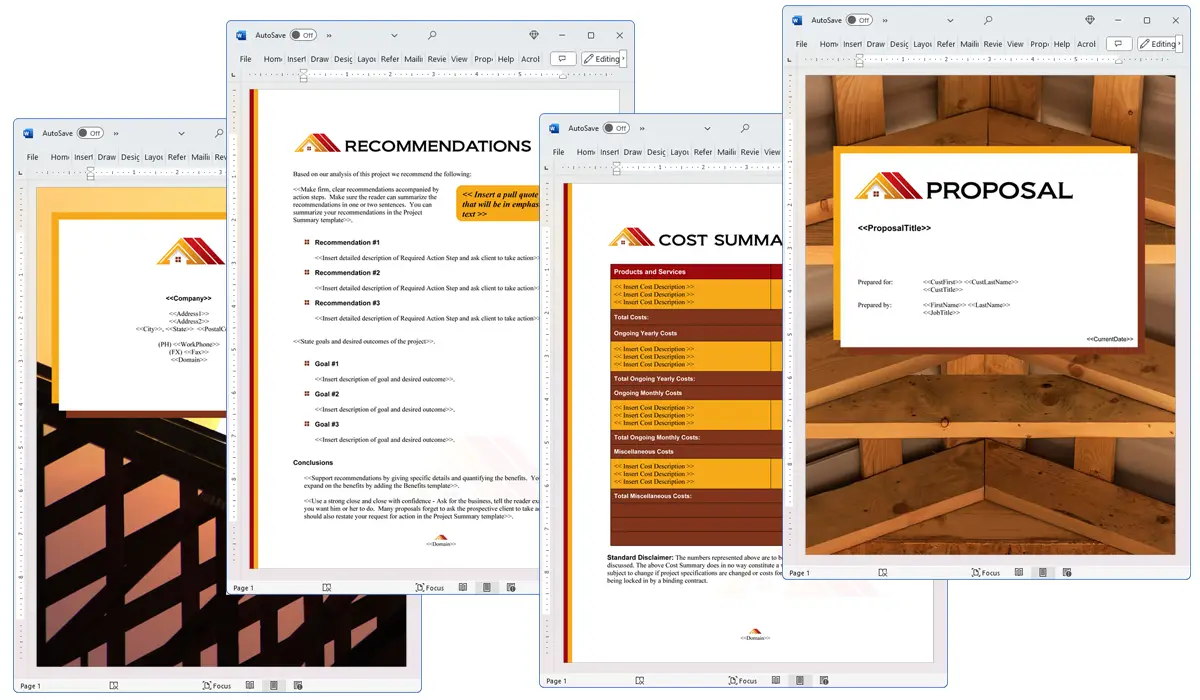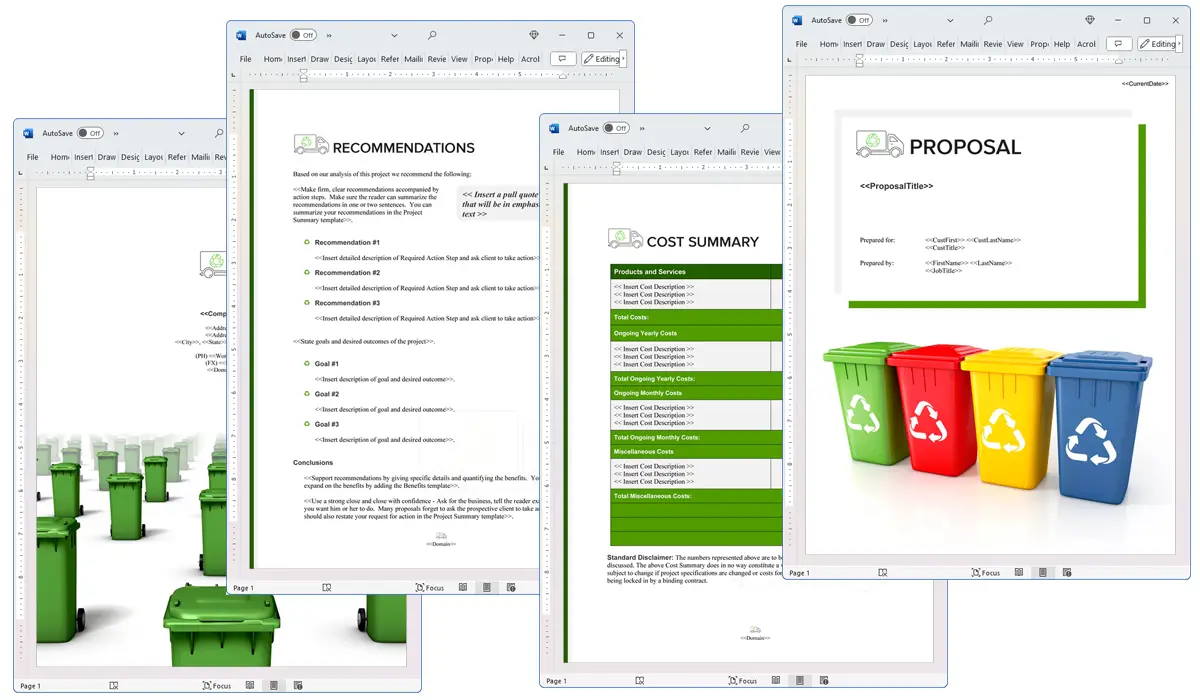What is the Commonalities chapter used for?
Proposal Kit Professional Bundle adds more design themes, all six Contract Packs,
a project management library, and Expert Edition software.

Illustration of Proposal Pack Roofing #2
We include this Commonalities chapter template in every Proposal Pack, along with thousands more. You assemble this chapter with others in various combinations to create custom-tailored business proposals, plans, reports, and other documents. Proposal Packs apply custom visual designs to the templates, giving the final documents a consistent professional finish.
 DOWNLOADABLE, ONE-TIME COST, NO SUBSCRIPTION FEES
DOWNLOADABLE, ONE-TIME COST, NO SUBSCRIPTION FEES
Overview of the Commonalities Chapter
The Commonalities chapter is a useful component in the creating of business proposals, especially when the aim is to establish or reinforce partnerships and collaborations. This chapter serves as a platform to highlight the shared interests, goals, or characteristics between your organization and another party. By identifying and emphasizing these commonalities, the proposal can more argue for the potential success and harmony of the proposed arrangement.
How is the Commonalities Chapter Used?
In business proposals, the Commonalities chapter is used to build a solid foundation for partnership or collaboration. This chapter is particularly critical when you need to convince the other party that there is a significant overlap in values, objectives, or histories, making the proposed alliance advantageous. It acts as a persuasive tool to ease any concerns about compatibility and to showcase the natural alignment between the entities involved.
What is Included in the Commonalities Chapter?
Typically, the Commonalities chapter includes:
- A detailed discussion of shared goals or objectives that both parties aim to achieve.
- Examples of similar projects or initiatives both entities have previously engaged in.
- Evidence of shared values or principles, which could be in the form of mission statements or corporate philosophies.
- A brief history of past interactions or partnerships between the entities, if applicable.
- Any mutual benefits that are expected to arise from the proposed collaboration.
Use Case Examples for the Commonalities Chapter
- Joint Ventures: Highlighting shared economic or market interests that make a joint venture beneficial for both parties.
- Non-profit Collaborations: Demonstrating shared missions and societal goals between non-profits seeking to amplify their impact through partnership.
- Technology Alliances: Outlining mutual technological goals or complementary technological capabilities between companies.
- Research Partnerships: Showcasing common academic interests and objectives in joint research initiatives, especially in universities or between educational institutions and industries.
- Cultural Exchanges: Emphasizing shared cultural values or educational goals in proposals for cultural exchange programs between countries or organizations.
Key Takeaways
- The Commonalities chapter is crucial for proposals aiming to establish or strengthen partnerships.
- It uses shared goals, values, and histories to argue for the compatibility and potential success of a collaboration.
- This chapter typically includes discussions of mutual benefits, similar past projects, and shared objectives.
- It is particularly effective in contexts such as joint ventures, non-profit collaborations, and technology alliances.
- Proper use of the Commonalities chapter can significantly enhance the persuasive power of a business proposal.

Illustration of Proposal Pack Sports #7
 What Our Clients Say
What Our Clients SayI’ve used an older version of this product for several years now with fantastic results. This saves a lot of time with compiling reports and documents that are required during my graduate courses and daily business proposals in the project management field. Combined with the technology template pack this has provided everything I have needed to get everything organized and looking professional."
 4.7 stars, based on 849 reviews
4.7 stars, based on 849 reviewsRelated Chapters

The Commonalities chapter and other chapters are integrated into a Word document as illustrated here in the Proposal Pack Sanitation #1 design theme. There are hundreds of design themes available, and every design theme includes the Commonalities chapter template.
A proper business proposal will include multiple chapters. This chapter is just one of many you can build into your proposal. We include the complete fill-in-the-blank template in our Proposal Pack template collections. We also include a library of sample proposals illustrating how companies in different industries, both large and small, have written proposals using our Proposal Packs. This template will show you how to write the Commonalities.
We include a chapter library for you to build from based on your needs. All proposals are different and have different needs and goals. Pick the chapters from our collection and organize them as needed for your proposal.
Using the Proposal Pack template library, you can create any business proposal, report, study, plan, or document.
The Wizard software includes an AI Writer, which will write the content of this and any other chapter of your document. Use the AI Writer to do the heavy lifting, writing the first draft of your proposal or business document in minutes.
 Ian Lauder has been helping businesses write their proposals and contracts for two decades. Ian is the owner and founder of Proposal Kit, one of the original sources of business proposal and contract software products started in 1997.
Ian Lauder has been helping businesses write their proposals and contracts for two decades. Ian is the owner and founder of Proposal Kit, one of the original sources of business proposal and contract software products started in 1997.By Ian Lauder
 Published by Proposal Kit, Inc.
Published by Proposal Kit, Inc.


 Cart
Cart
 Facebook
Facebook YouTube
YouTube Bluesky
Bluesky Search Site
Search Site